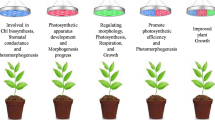Abstract
Photosynthesis and transpiration were simultaneously measured under different light intensity, temperature and humidity conditions inSasa nipponica andArundinaria pygmaea grown in exposed and shaded habitats. Both species showed a saturated light curve for photosynthetic rate. The saturation point was lower in shaded plants. The apparent quantum yields were larger inS. nipponica and in shaded plants, while the maximum photosynthesis was higher inA. pygmaea and exposed plants. The temperature response of photosynthesis showed an optimum curve in both species. The optinum temperatures were 20 C inS. nipponica and 25 C inA. pygmaea. The influence of humidity on photosynthesis was insignificant for both species. The responses of transpiration to light intensity and relative humidity showed a saturated curve and an optimal one, respectively. There was a significant relationship between transpiration and stomatal frequency, both of which were higher inS. nipponica, while water use efficiency was higher inA. pygmaea. These results suggest thatS. nipponica adapts itself better to shaded, low temperature and less water stress habitats as compared withA. pygmaea.
Similar content being viewed by others
References
Agata, W. andE. Kamata. 1979. Ecological characteristics and dry matter production of some native grasses in Japan. I. Annual growth pattern ofSasa nipponica community. J. Japan. Grassl. Sci.25: 103–109.
Arnon, D.I. 1949. Copper enzymes in isolated chloroplast. Polyphenoloxidase inBeta vulgare. Plant Physiol.24: 1–15.
Björkman, O. andP. Holmgren. 1963. Adaptability of the photosynthetic apparatus to light intensity in ecotype from exposed and shaded habitats. Physiol. Plant.16: 889–914.
Black, C.C. 1971. Ecological implications of diving plants into groups with distinct photosynthetic productions capacities. Advan. Ecol. Res.7: 87–114.
Brown, R.H. andR.E. Simmons. 1979. Photosynthesis of grass species differing in CO2 fixation pathways. I. Water use efficiency. Crop. Sci.19: 375–379.
Bull, T.A. 1969. Photosynthetic efficiencies and photorespiration in calvin cycle and C4-dicarboxyric acid plants. Crop. Sci.9: 726–729.
Burnside, C.A. andR.H. Bohning. 1957. The effect of prolonged shading on the light saturation curves of apparent photosynthesis in sun plants. Plant Physiol.32: 61–63.
Ehleringer, J.R. 1979. Implication of quantum yield differences on the distribution of C3 and C4 grasses. Oecologia31: 255–267.
Hozumi, K., K. Yoda andT. Kira. 1969. Production ecology of tropical rain forests in south western Cambodia. II. Photosynthetic production in an evergreen seasonal forest. Nature and Life in SE. Asia6: 57–81.
Itow, S. 1966. A note on ecology ofSasa andArundinaria species in grassland vegetation of Japan. Bull. Grassl. Ecol. Res. Gr.7: 34–41.
Jones, H.G. 1976. Crop characteristics and the ratio between assimilation and transpiration. J. Appl. Ecol.13: 605–622.
Kusumoto, T. 1961. An ecological analysis of the distribution of broad-leaved evergreen trees, based on the dry matter production. Jap. J. Bot.17: 307–331.
Ludlow, M.M. 1981. Effect of temperature on light utilization efficiency of leaves in C3 legumes and C4 grasses. Photosyn. Res.1: 243–249.
Machler, F. andJ. Nosberger. 1977. Effect of light intensity and temperature on apparent photosynthesis of altitudinal ecotypes ofTrifolium repens L. Oecologia31: 73–78.
Mahall, B.E., V.T. Parker andP.J. Fonteyn. 1981. Growth and photosynthetic irradiance responses ofAvena fatua L. andBromus diandrus Roth. and these ecological significance in California savannas. Photosynthetica15: 5–15.
Monson, R.K., R.O. Littlejohn, Jr. andG.J. Williams, III. 1983. Photosynthetic adaptation to temperature in four species from the Colorado shortgrass steppe: a physiological model for coexistence. Oecologia58: 43–51.
Mooney, H.A. andW.D. Billings. 1961. Comparative physiological ecology of arctic and alpine populations ofOxyria digyma. Ecol. Monog.31: 1–29.
Murata, Y., J. Iyama andT. Honma. 1965. Studies on the photosynthesis of forage crops. IV. Influence of air-temperature upon the photosynthesis and respiration of alfalfa and several southern type forage crops. Proc. Crop Sci. Soc.34: 154–158.
Numata, M. 1961. Ecology of grassland in Japan. J. Coll. Arts and Sci., Chiba Univ.3: 327–342.
— 1979. The relationship of limiting factors to the distribution and growth of Bamboo.In: M. Numata, ed. Ecology of Grasslands and Bamboolands in the World p. 259–275. Dr. W. Junk bv Publishers, Hague.
Ohwi, J. 1965. Flora of Japan. Shibundo, Tokyo.
Oshima, Y. 1961. Ecological studies of Sasa communities. III. Photosynthesis and respiration ofSasa kurilensis. Bot. Mag. Tokyo74: 349–356.
Rawson, H.M. andJ.E. Begg. 1977. The effect of atomospheric humidity on photosynthesis, transpiration and water use efficiency of leaves of several plant species. Planta134: 5–10.
Sawada, S. andS. Miyachi. 1974. Effects of growth temperature on photosynthetic carbon metabolism in green plants. I. Photosynthetic activities of various plants acclimatized to varied temperatures. Plant Cell Physiol.15: 111–120.
Slatyer, R.O. 1977. Altitudinal variation in the photosynthetic characteristic of snow gum,Eucalyptus pauciflora Sieb. ex Spreng. III. Temperature response of material grown in contrasting thermal environments. Aust. J. Plant Physiol.4: 301–312.
— andP.J. Ferror. 1977. Altitudinal variation in the photosynthetic characteristics of snow gum,Eucalyptus pauciflora Sieb. ex Spreng. II. Effects of growth temperature under controlled conditions. Aust. J. Plant Physiol.4: 289–299.
Soderstron, T.R. andC.E. Calderon. 1979. Distribution and environment of theBambusoideae.In: M. Numata, ed., Ecology of Grasslands and Bamboolands in the World p. 223–236. Dr. W. Junk bv Publishers, Hague.
Suzuki, S. 1961. Ecology of the Bambusaceaus generaSasa andSasamorpha in the Kanto and Tohoku districts of Japan, with special reference to their geographical distribution. Ecol. Rev.15: 131–147.
Usui, H. 1961. Photosociological revision of the dominant species of Sasa-type undergrowth (Silvicultural application of the researches on Japanease forest vegetation). Bull. Coll. Agr. Utsunomiya Univ.11: 1–35.
Author information
Authors and Affiliations
Rights and permissions
About this article
Cite this article
Agata, W., Hakoyama, S. & Kawamitsu, Y. Influence of light intensity, temperature and humidity on photosynthesis and transpiration ofSasa nipponica andArundinaria pygmaea . Bot Mag Tokyo 98, 125–135 (1985). https://doi.org/10.1007/BF02488792
Received:
Issue Date:
DOI: https://doi.org/10.1007/BF02488792




